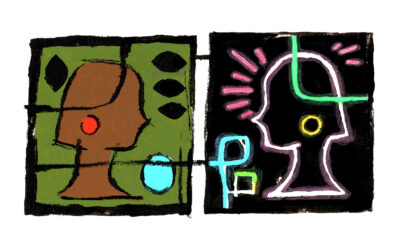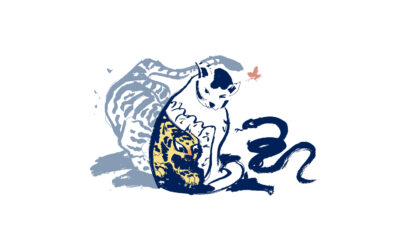Promises of the future are a powerful marketing tool: from daily skincare regimens to make a difference twenty years down the line, to financial services promising a carefree life in old age if you invest wisely right now. But how do brands communicate this vague, abstract concept of ‘the future’?
Using a semiotic lens, we uncovered to visually signal the future there are three broad pillars that brands tend to use, which are almost universally recognisable.
*Commercial Semiotics is the practice of creating commercial meaning and value from decoding culture; it is a mode of mapping out cultural tropes akin to ‘reading images’ in their wider contextual framework.

This article lays out the key pillars of an aesthetic we would call ‘future-core’. These are fairly common, universal ways that future is represented. In a next piece (link), we will look at how a brand is bringing ideas of the future to life on its own terms, putting a unique spin on it and making its own version of future core.
Three Broad Pillars
1. Colour
Images of tradition and rustic calm tend to feature earth tones in low saturation, such as browns, greens, and off-white hues. In contrast, the future is often depicted with highly saturated colours at the opposite end of the colour wheel, conveying a move away from tradition. Cool-toned whites also evoke metals and glass, conveying the shine and finish of synthetic materials.
As such, the future appears to have a somewhat limited colour palette, at least in our visual imagination. There is an abundance of blues, purples, silvers, and whites, as seen in this depiction of Virtual Akihabara. These colours are artificial in nature and show how our general conception of future is one created by machines and technology.
 Source: at-living.press
Source: at-living.press
 Source: adidas.com
Source: adidas.com
Take FUTURECRAFT.STRUNG as another example. A concept shoe by Adidas, it illustrates a pioneering technique of data-driven shoe design and production. Using STRUNG, shoes will be unique to runner profiles, seamless, and more precisely fit than ever before. In the graphic, the subtle gradient from pink to blue in the background conveys a dynamic yet gentle movement. The cool pinks, blues, and orange of the shoe itself draw the eye. Subtle white highlights in the background evoke schematics and diagrams, communicating the future-forward approach of the product.
Here too the colour is in essence artificial but has been toned down to evoke a symbiotic state between pure futurism and naturalism.
2. Seamless Design and Form
While it is an evocative tool, colour alone is not enough. The second pillar to signal the future is the seamless integration of design and form, which communicates harmony between different components.
For example, this concept car appears to be wrought out of one seamless piece of metal, without doors or a steering wheel, demonstrating a hyper-simplified user interface with a glossy finish. Here, the blues and cool purples point us toward the future, but more centrally, the future is signalled through design and form that is sleek, unimodal in colour, material, and finish.

Source: メルセデス・ベンツ ビジョンAVTR
The design of the car may also reflect designers’ perspectives on future transport infrastructures. How fast is an aerodynamic car like this intended to move? Would traffic be so well-organised that we could drive at much higher speeds? Futuristic products and buildings prompt us to imagine the broader environments they would function in.
Zaha Hadid’s distinctive architectural style is another strong example of seamless design and form, with bold and distinctive designs that have transformed skylines all over the world.

Source: CNN.co.jp
One of Azerbaijan’s most iconic buildings, the Heydar Aliyev Center embodies Hadid’s fluid architectural style. Though there are multiple levels, separate buildings, and rooms, the design suggests one form that flows as a coherent body.
3. Juxtaposition of the Organic and Inorganic
This brings us to the third pillar: a juxtaposition of the organic and inorganic elements. In the image above, silhouettes of leaves sit in the foreground while the car itself is in focus. In other images of the future, there is often an interesting bridge between technology and nature. Organic, curved shapes are built out of inorganic materials, demonstrating a new relationship to nature.
This concept by Vincent Callebaut, The Dragonfly, was inspired by the wings of the dragonfly. The glass and steel structure would integrate natural ventilation and solar energy in a multi-use development suitable for farming, research, and housing.
 Source: ecofriend.com
Source: ecofriend.com
On a much smaller scale, the TOTO Neorest NX Series toilets—hailed as the ‘future of flushing’—are shaped like pebbles smoothed by water.

Source: TOTO global site
Staged against an impossibly clean, cool-toned white backdrop, the Neorest’s soft, elliptical profile stands in contrast to our perception of ceramic as a sturdy, heavy material.
These three pillars work together to transport a viewer beyond the here and now. Otherworldly environments house products and objects that are impossible to achieve in the present, communicating a sense of the future.
Outdated Future: the Constant Reinvention of New Futures
In some ways, our visualisations of the future have barely changed. We look for original designs and forms in surprising visual contexts, which create a sense of transcendence. Yet within these pillars, there are constant shifts in the nuances of colour, design cues, and what constitutes ‘the future’.
Looking back, we can often recognise when something looked futuristic when it was released but is no longer cutting-edge. Take this Nike sneaker, for instance. It employs some pillars of futuristic signalling—whites, blues, and some attempt at clarity in lines for a sleek effect.

Source: Photo by: Nicholas Hunt/MJF2016 via Getty Images
However, the roundness of the toe and chunky soles are commonplace in the fashions of today. This design has lost its sense of otherworldliness. The product itself did not change to become more old-school, but from the context of a contemporary perspective, it feels retro-futuristic rather than purely futuristic.
What is so intriguing about all this is that our dreams of the future hardly come true in real life. Nor, it seems, do we want them to. Cars that were futuristic in the 1950s are technologically achievable now but are not appealing to consumers of today. Similarly, concept cars that we see today will likely never make it to a production line, let alone become the new norm of the future.
Rather than actualising our ideas of the future, we conceptualise new futures to strive towards. The most alluring future is the one that beckons to us from a distant horizon—close enough to entice us, but always just out of reach.


